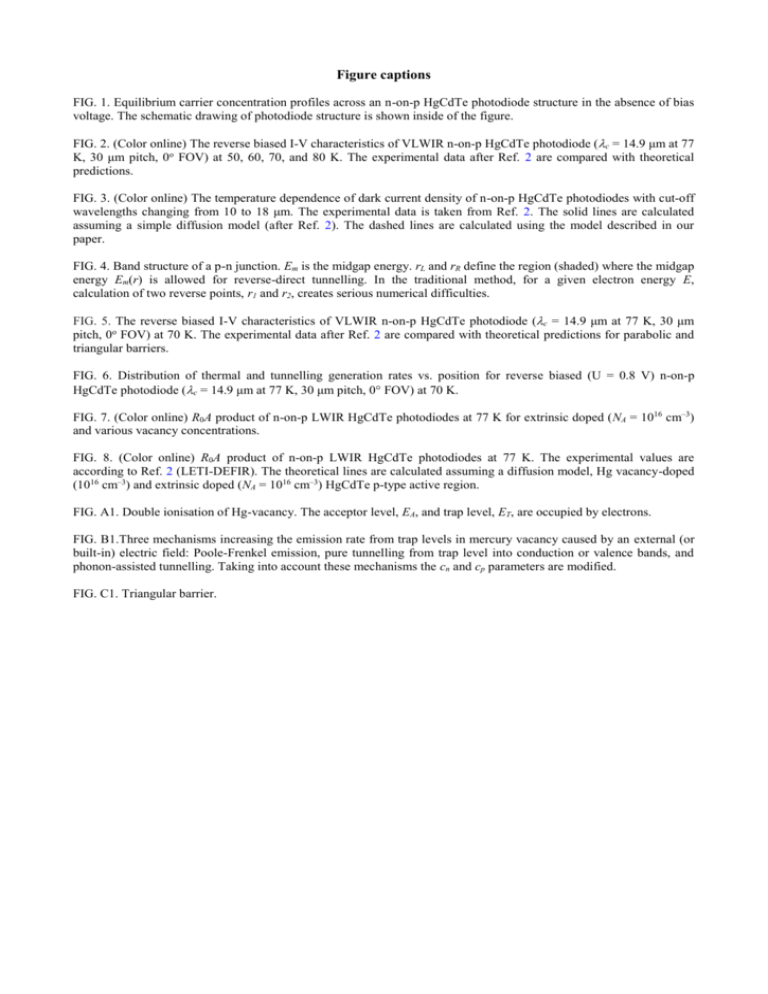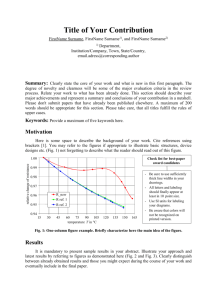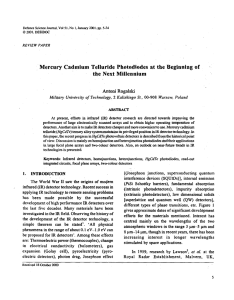Figure_captions
advertisement

Figure captions FIG. 1. Equilibrium carrier concentration profiles across an n-on-p HgCdTe photodiode structure in the absence of bias voltage. The schematic drawing of photodiode structure is shown inside of the figure. FIG. 2. (Color online) The reverse biased I-V characteristics of VLWIR n-on-p HgCdTe photodiode (c = 14.9 μm at 77 K, 30 μm pitch, 0o FOV) at 50, 60, 70, and 80 K. The experimental data after Ref. 2 are compared with theoretical predictions. FIG. 3. (Color online) The temperature dependence of dark current density of n-on-p HgCdTe photodiodes with cut-off wavelengths changing from 10 to 18 μm. The experimental data is taken from Ref. 2. The solid lines are calculated assuming a simple diffusion model (after Ref. 2). The dashed lines are calculated using the model described in our paper. FIG. 4. Band structure of a p-n junction. Em is the midgap energy. rL and rR define the region (shaded) where the midgap energy Em(r) is allowed for reverse-direct tunnelling. In the traditional method, for a given electron energy E, calculation of two reverse points, r1 and r2, creates serious numerical difficulties. FIG. 5. The reverse biased I-V characteristics of VLWIR n-on-p HgCdTe photodiode (c = 14.9 μm at 77 K, 30 μm pitch, 0o FOV) at 70 K. The experimental data after Ref. 2 are compared with theoretical predictions for parabolic and triangular barriers. FIG. 6. Distribution of thermal and tunnelling generation rates vs. position for reverse biased (U = 0.8 V) n-on-p HgCdTe photodiode (c = 14.9 μm at 77 K, 30 μm pitch, 0° FOV) at 70 K. FIG. 7. (Color online) R0A product of n-on-p LWIR HgCdTe photodiodes at 77 K for extrinsic doped (NA = 1016 cm–3) and various vacancy concentrations. FIG. 8. (Color online) R0A product of n-on-p LWIR HgCdTe photodiodes at 77 K. The experimental values are according to Ref. 2 (LETI-DEFIR). The theoretical lines are calculated assuming a diffusion model, Hg vacancy-doped (1016 cm–3) and extrinsic doped (NA = 1016 cm–3) HgCdTe p-type active region. FIG. A1. Double ionisation of Hg-vacancy. The acceptor level, EA, and trap level, ET, are occupied by electrons. FIG. B1.Three mechanisms increasing the emission rate from trap levels in mercury vacancy caused by an external (or built-in) electric field: Poole-Frenkel emission, pure tunnelling from trap level into conduction or valence bands, and phonon-assisted tunnelling. Taking into account these mechanisms the cn and cp parameters are modified. FIG. C1. Triangular barrier.









